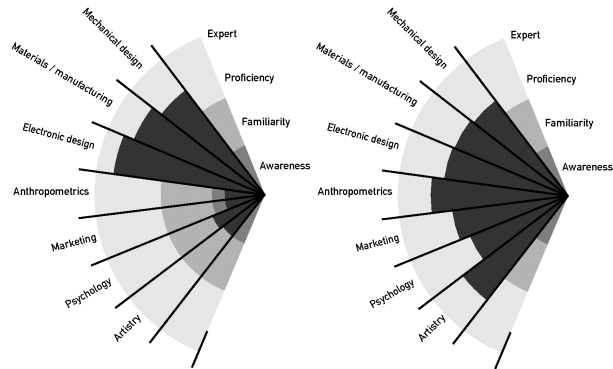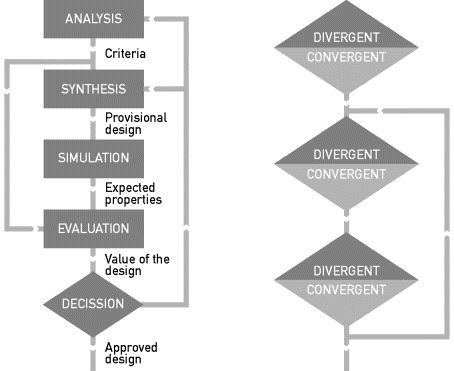1.4 Industrial Design Engineering
Since the discipline of industrial design engineering plays a key role in product development and hence forms a pivot of this book, it would be relevant to explore the setting and definitions of industrial design engineering and hence create a common understanding about this discipline among our readers.
In the scholarly practice, the discipline of design can be split up into three main subdomains: (1) industrial design (ID), (2) industrial design engineering (IDE), and (3) design engineering (DE; Figure 1.4.1).
Figure 1.4.1 The three subdomains of design

The origin of these three domains varies. Industrial design, on one hand, has its roots in the arts and crafts (Cross, 1990; Lofthouse, 2004) and is often taught at art academies. Design engineering, on the other hand, is based on technology and technological models (Buijs, 2003; Lofthouse, 2007; Pahl and Beitz, 1984; Roozenburg and Eekels, 1998) and is mostly lectured at technical universities and engineering schools. Industrial design engineering can be seen as a combination of the previous two, with its roots in both engineering design and industrial design (Buijs, 2003).
The subdomains of design differ not only in their background but also in their way of approaching and solving design problems. For example, Lofthouse (2004) pointed out that the industrial designer is predominantly an imaginative, intuitive, creative, innovative, or divergent thinker who is unstructured, at times aimless, and inwardly directed. In contrast, the design engineer is a reasoning, rational, or convergent thinker who is logical, purposeful, and concerned with outward-directed problem solving. Design engineers use scientific principles, technical information, and imagination in defining the mechanical structure, machine, or system that can perform prespecified functions with maximum economy and efficiency. In addition, the “typical” industrial designer has proficiencies across a wide range of skill sets such as artistry, mechanical design, marketing, and psychology, whereas the “typical” design engineer is an expert in a restricted amount of topics, mainly related to mechanical design, materials and manufacturing, and electronic design (Bates and Pedgley, 1998; Lofthouse, 2004). The different knowledge and skill portfolios of industrial designers and design engineers are illustrated in Figure 1.4.2.
Figure 1.4.2 Differences in skills and knowledge of design engineers (left) and industrial designer (right) (Bates and Pedgley, 1998)

This broad variation in skills and knowledge is reflected in definitions existing within the field of IDE. For instance, the International Council of Societies of Industrial Design (ICSID, 2005) defines industrial design as:
a creative activity whose aim is to establish the multi-faceted qualities of objects, processes, services and their systems in whole life-cycles. Therefore, design is the central factor of innovative humanization of technologies and the crucial factor of cultural and economic exchange.
According to Heskett (1980), industrial design is a process of creation, invention, and definition separated from the means of production, involving an eventual synthesis of contributory and often conflicting factors into a concept of three-dimensional form, and its material reality, capable of multiple reproduction by mechanical means. Finally, the Industrial Designers Society of America (IDSA, 2005) describes industrial design as:
the professional service of creating and developing concepts and specifications that optimize the function, value and appearance of products and systems for the mutual benefit of both user and manufacturer. They develop these concepts and specifications through collection, analysis and synthesis of data guided by the special requirements of the client or manufacturer. They are trained to prepare clear and concise recommendations through drawings, models and verbal descriptions.
For the purpose of this book, the IDSA definition will be followed.
At present, the role and impact of industrial design in the Western world are still increasing. Today industrial designers are called upon not only to design new products but also to manage the processes by which they are produced and get involved in the strategic aspects of production. This expanded role for design has resulted in explosive growth among professional design firms and the corporate sectors associated with design in developed countries. Even though it is not always recognized, industrial design can be a key factor in the competitiveness of a company and its products, as it improves and strengthens a company's market position and helps the company's products convey a different, innovative image. Companies that invest in design tend to be more innovative, more profitable, and faster growing than those that do not (DZDesign, 1996; EU, 2009). This is confirmed by other studies on the Dutch design sector by TNO (2005) and a recent survey of UK manufacturing firms (Confederation of British Industry, 2008). These studies clearly state the significant contribution of IDE to the competitiveness of industry.
Designing can be seen as a range of activities over time. To support the industrial designer in this process, many scholars have developed design methodologies. A common definition of design methodology is provided by Cross (1984):
the study of the principles, practices and procedures of design in a broad and general sense. Its central concern is with how designing both is and might be conducted. This concern therefore includes the study of how designers work and think; the establishment of appropriate structures for the design process; the development and application of new design methods, techniques, and procedures; and reflection on the nature and extent of design knowledge and its application to design problems.
Much of the early methodology was compiled by engineers who applied the same “system thinking” they had used in designing their products to analyze the design process itself. The first thing that design researchers did, based on their own practices as professional product designers, was to cut the product innovation process into little pieces, which they ordered in a kind of logical way (Buijs, 2003). Within this context various design methodologies have been developed by Pahl and Beitz (1984; shown in Figure 1.4.3) and Roozenburg and Eekels (1998; see Figure 1.4.4).
Figure 1.4.3 Flow chart representing the basic industrial design method of Pahl and Beitz (1984)

Figure 1.4.4 The basic cycle of design (Roozenburg and Eekels, 1998) characterized by divergent, convergent, and iterative activities

The basic industrial design method of Pahl and Beitz (1984), which is widely acknowledged and used in design engineering, consists of four phases: (1) clarification of the task, (2) conceptual design, (3) embodiment design, and (4) detail design. In the first three phases, product designers seek to optimize a product's working principle. The last three phases involve optimizing a product's layout and form. Thus, conceptual and embodiment design form the connecting links between technology, on one hand, and design/styling and ergonomics, on the other.
Roozenburg and Eekels (1998) developed a design methodology for industrial design based on analysis of a different model for the product design process; this resulted in the notion of a basic design cycle (see Figure 1.4.4). The basic design cycle encompasses all the phases a design process will go through at least once. It consists of a number of activities, each divergent, convergent, and iterative components. The cycle starts with a function that is analyzed, resulting in criteria; following that, synthesis takes place, resulting in a provisional design; that design is simulated, resulting in expected properties; these properties are evaluated, resulting in an outcome; then, finally, a decision is taken whether or not to continue (Roozenburg and Eekels, 1998). This analyze–synthesize–simulate–evaluate–decide approach is still the kernel of the present Delft innovation model, which is included in Section 2.3 of this book.
